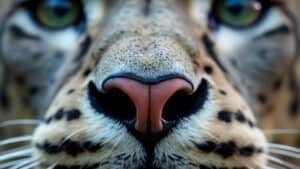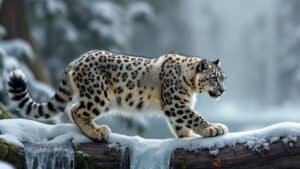Introduction
The snow leopard’s claws are a marvel of natural engineering, finely tuned for survival in the rugged mountains of Central Asia. These sharp, retractable tools are essential for hunting, providing the snow leopard with the ability to stalk, capture, and secure prey with precision
In this article, we will explore the structure of snow leopard claws, how they differ from those of other big cats, and the critical role they play in hunting. We will also examine how these claws aid in navigating their challenging environment and contribute to their stealthy approach in the wild
Anatomy of Snow Leopard Claws
The claws of a snow leopard are one of its most vital tools for survival, intricately designed to perform a variety of functions
These claws are not only essential for hunting but also play a critical role in climbing, defending against threats, and navigating the snow-covered terrain of their mountainous habitat
Key Anatomical Features
Snow leopard claws are sharp, curved, and retractable, making them both powerful and versatile. The claws are attached to the last bone of each toe, known as the distal phalanx
This bone structure allows the claws to be extended when needed and retracted when not in use, helping to prevent wear and tear. The retractable nature of the claws also allows snow leopards to move silently, a crucial advantage when stalking prey
Each claw is covered in a hard keratin sheath, which provides durability and sharpness. The sharp tip of the claw is slightly curved, allowing the snow leopard to hook into the flesh of its prey or grip onto rocky surfaces during a climb
The snow leopard has five claws on each of its front paws, including a dewclaw that is positioned higher up on the paw, which is particularly useful for gripping and holding onto prey
Differences Compared to Other Big Cats
While all big cats possess retractable claws, snow leopard claws have certain adaptations that make them uniquely suited to their environment. Compared to other big cats like lions or tigers, snow leopard claws are shorter and more heavily curved
This design is particularly beneficial for climbing steep, rocky surfaces, which is a common activity in the mountainous regions they inhabit
Additionally, the paw pads of snow leopards are covered in fur, unlike those of many other big cats. This fur not only insulates the paws against the cold but also provides additional traction on slippery surfaces
The claws work in tandem with the padded paws to give snow leopards a stable grip on uneven or icy terrain, enhancing their ability to move efficiently and quietly through their environment
Mechanism of Retraction and Extension
The retraction and extension of snow leopard claws are controlled by a system of tendons and muscles. When the snow leopard is at rest or walking, the claws are retracted, hidden within protective sheaths in the toes
This retraction is achieved through the contraction of a tendon attached to the claw, which pulls it back into its sheath. This mechanism helps protect the claws from damage and keeps them sharp for when they are needed
When the snow leopard prepares to hunt or climb, the muscles in the paws contract, extending the claws out of their sheaths. This action is swift and allows the claws to be deployed almost instantly when required. The ability to quickly extend and retract claws is crucial during hunting, where timing and precision can mean the difference between a successful capture and a missed opportunity
The extension of the claws is also associated with the spreading of the toes, which increases the surface area of the paw and enhances the snow leopard’s grip. This combination of extended claws and spread toes is particularly effective when the snow leopard is gripping onto prey or clinging to a narrow ledge in its rugged terrain
Role of Claws in Hunting
The snow leopard’s claws are indispensable tools in the art of hunting. These sharp, retractable weapons are perfectly adapted to the snow leopard’s environment and hunting style, allowing them to stealthily approach, capture, and secure prey in the rugged mountainous regions they call home
How Claws Assist in Stalking Prey
Stalking is a critical phase in the snow leopard’s hunting process, requiring silence, patience, and precision. The retractable nature of the claws plays a crucial role during this phase. When retracted, the claws are sheathed within the toes, which allows the snow leopard to move almost silently across the terrain
This stealth is essential, as snow leopards often need to get very close to their prey before launching an attack due to the challenging environment and the agility of their prey, such as blue sheep and ibex
The snow leopard’s large, fur-covered paws also aid in stalking by providing traction and reducing noise on the snow-covered ground. The fur on their paws acts as a natural muffler, while the retracted claws prevent any unnecessary scratching sounds that might alert potential prey
This combination of stealthy movement and precise control over their claws allows snow leopards to approach within striking distance without being detected
Using Claws to Capture and Secure Prey
Once within range, the snow leopard’s claws become its primary weapons for capturing prey. With a powerful leap, the snow leopard uses its front claws to latch onto the prey, digging deep into the flesh to secure a firm grip
The curved shape of the claws ensures that once they penetrate, they are not easily dislodged, allowing the snow leopard to maintain control over even large and struggling prey
The dewclaw, located higher on the front paws, is particularly useful in this process. When the snow leopard grabs its prey, the dewclaw acts like a thumb, helping to hold onto the prey more effectively, especially during the struggle that often ensues after the initial capture
This is particularly important when dealing with larger animals, as the snow leopard needs to secure its prey quickly to avoid a prolonged and dangerous struggle
After securing the prey with its claws, the snow leopard typically delivers a fatal bite to the neck or throat, severing the spinal cord or suffocating the animal
The claws help hold the prey in place during this critical moment, ensuring that the kill is quick and efficient. Without the claws to secure the prey, the snow leopard would have a much harder time immobilizing its target and making the kill
Techniques for Maintaining Claw Sharpness
Maintaining the sharpness of their claws is essential for snow leopards, as dull claws would hinder their ability to hunt effectively. Snow leopards regularly engage in behaviors that help keep their claws sharp and functional
One such behavior is claw sharpening, where the snow leopard scratches against tree trunks, rocks, or other hard surfaces. This action helps to remove the outer sheath of the claw, revealing the sharper, newer claw underneath
In addition to sharpening, snow leopards retract their claws when not in use, which helps preserve their sharpness. This protective mechanism ensures that the claws remain sharp and ready for action, whether for hunting or climbing. Snow leopards also groom their paws and claws regularly, using their teeth to clean away debris and keep the claws in optimal condition
These maintenance behaviors are crucial for the snow leopard’s survival. Sharp claws are not only vital for hunting but also for climbing, defending territory, and protecting themselves from threats
The combination of regular sharpening, grooming, and the natural retractable design of their claws ensures that snow leopards are always ready to hunt with precision and efficiency
Claws and Environmental Adaptation
The snow leopard’s claws are not only vital for hunting but also play a significant role in their ability to navigate and survive in the extreme environments of their mountainous habitats
These claws, combined with other physical adaptations, enable snow leopards to thrive in some of the most challenging terrains on Earth
Navigating the Mountainous Terrain
Snow leopards inhabit the rugged, high-altitude regions of Central Asia, where steep cliffs, rocky outcrops, and deep snow are common. Their claws are perfectly adapted to help them navigate these treacherous landscapes
The sharp, curved claws allow snow leopards to climb steep rock faces and maintain a secure grip on narrow ledges. This ability to climb is crucial for both hunting and avoiding predators or human threats
The claws also assist in traversing snowy and icy terrain. The snow leopard’s paws are large and wide, acting like snowshoes that distribute their weight more evenly across the snow
The claws provide additional traction, preventing the snow leopard from slipping on icy surfaces and allowing them to move with confidence across the frozen ground. This combination of paw and claw adaptations is essential for their mobility and survival in these cold, inhospitable environments
Dual Use: Hunting and Defense
While hunting is the primary use of their claws, snow leopards also rely on them for defense. These big cats are generally solitary and elusive, but they can become aggressive when threatened
In such situations, their claws serve as formidable weapons. The snow leopard can deliver powerful swipes with its front paws, using its sharp claws to inflict serious injuries on potential threats
In addition to self-defense, the claws are used in territorial disputes with other snow leopards. Although direct conflicts are rare, when they do occur, the claws are used to assert dominance and protect valuable hunting grounds
The ability to defend territory effectively ensures that snow leopards have access to the resources they need to survive, such as prey and shelter
Silent Movement and Stealthy Approaches
Stealth is a key survival strategy for snow leopards, and their claws play a critical role in this aspect of their behavior
As mentioned earlier, the retractable nature of their claws allows them to move silently, reducing the chance of alerting prey or other predators. This silent movement is especially important during hunting, where a successful approach often depends on the element of surprise
The snow leopard’s environment, with its open landscapes and limited cover, makes it difficult to approach prey undetected. Therefore, every advantage in stealth is crucial. By retracting their claws, snow leopards minimize noise, enabling them to get as close as possible before launching an attack. This ability to move quietly and strike suddenly is a key factor in the snow leopard’s hunting success
Moreover, the combination of their sharp claws and powerful limbs allows snow leopards to maintain their grip on prey even on steep, slippery slopes, where a fall could be fatal. This adaptation is vital for hunting in their mountainous habitats, where the terrain often presents as much of a challenge as the prey itself
Conclusion
The claws of a snow leopard are much more than mere tools; they are a vital adaptation that enables these magnificent cats to thrive in the harsh, mountainous regions they inhabit
From the intricate anatomy that allows for silent stalking and powerful strikes during hunts to the crucial role they play in navigating rugged terrain and defending against threats, these claws are central to the snow leopard’s survival strategy
Understanding the structure and function of snow leopard claws not only highlights the incredible adaptability of this species but also underscores the importance of preserving their natural habitats, ensuring that snow leopards continue to roam the high mountains of Asia for generations to come













